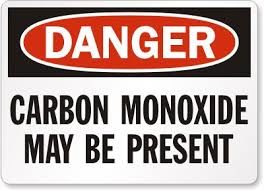
Avoiding Carbon Monoxide Poisoning During Power Outages
After major hurricanes like Harvey and Irma, one of the gravest dangers to those who survived the storms is the threat of carbon monoxide poisoning. In the days following Hurricane Irma, many families have become ill from carbon monoxide poisoning. Tragically several people have died from it, including a seven-year-old girl from Polk County, Florida. Carbon monoxide poisoning is so common after these storms. This is due to the long-lasting and widespread power outages that the hurricanes cause.
How Does This Happen?
Power outages generally lead to carbon monoxide poisoning in one of two ways.
- From the use of a generator to supply power.
- From the use of a grill or camp stove to cook food— anything that burns fuel produces carbon monoxide gas.
Carbon monoxide is an odorless, tasteless, invisible gas. Without a special carbon monoxide detector. You have no way of telling when it’s building up inside of your home.
According to the Centers for Disease Control and Prevention (CDC), breathing in carbon monoxide causes “flu-like” symptoms. This includes headache, dizziness, and nausea. It will eventually leading to unconsciousness and death. However, if you’re asleep when the poisoning occurs, you can die without ever being aware of the symptoms. Another symptom of poisoning is mental confusion. This means that by the time you might realize something is wrong, you may not be able to figure out what to do about it. All these things combined are what make carbon monoxide so dangerous and even deadly.
How Can You Help Prevent This?
As mentioned above, the only way to detect carbon monoxide gas building up in your home is through the use of a carbon monoxide detector. You can purchase carbon monoxide detectors that are combined with smoke alarms. A standard smoke alarm alone will NOT detect carbon monoxide. Since you’ll want to make sure your carbon monoxide detector works during power outages, you should get one that is either battery-operated or has a battery backup. Then make sure you change the batteries regularly, just like you should do with a smoke alarm. Carbon monoxide detectors should be placed near all sleeping areas. This will increase the chances that the alarm will be able to wake you up if a carbon monoxide build-up happens while you’re sleeping.
So in addition to installing carbon monoxide detectors in your home, how else can you decrease your risk of carbon monoxide poisoning during power outages? First of all, if you’re using a grill or camp stove to cook your food, never use it in the house or the garage. Always keep your grill or camp stove outside. Also keep it away from windows or vents into the house. This warning still applies to charcoal grills after you’ve finished cooking. A study by Iowa State University found that charcoal that appears to be extinguished can still produce carbon monoxide gas for many hours.
While grills and camp stoves can cause carbon monoxide poisoning, the number one cause of carbon monoxide poisoning during power outages is the use of portable generators. A generator can be very helpful to have during a power outage. This is especially true for one that lasts a long time. It’s extremely important to follow all of the manufacturer’s safety instructions to avoid risks like electrocution, fires, and carbon monoxide poisoning.
The Dangers of Generators
Generators pose an especially high risk for carbon monoxide poisoning because they produce a shockingly large amount of carbon monoxide. According to the US Consumer Product Safety Commission (CPSC), a single portable generator can produce as much carbon monoxide as HUNDREDS of cars. That’s why you should NEVER use a generator inside of your home, crawlspace, basement, or garage, not even for a short amount of time. A generator can cause deadly levels of carbon monoxide to build up in just a few minutes, even with all of your doors and windows open. The Red Cross warns that using a fan for ventilation isn’t sufficient either. The generator absolutely must be placed outdoors.
And simply placing the generator right outside of your house isn’t good enough either. This is because the generator produces so much carbon monoxide gas. It can quickly fill your home with deadly levels of poison even from outside. The CDC recommends that your portable generator be set up at least twenty feet away from your home. Which means you’re going to need a long extension cord! It’s particularly important to make sure your generator isn’t located near any doors, windows, or vents. This might allow even more of its exhaust into the house.
Sometimes homeowners place generators inside of garages or dangerously close to their home. This is because they’re worried about the generator being stolen. The CPSC recommends that you chain the generator to a tree or other fixed object if you’re concerned about it being stolen. And remember—you can always replace a generator. You cannot replace yours or your family’s lives.


